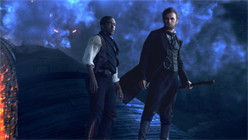Two films into his English-language directing career, and already Timur Bekmambetov is spinning his wheels. But at least when the Kazakh director does so, the wheels have glistening silver rims and spin in hyperdetailed, superslow motion, all while the car is spinning through the air in a graceful, arcing corkscrew.
Abraham Lincoln: Vampire Hunter has no cars, of course, but there are plenty of those post-Matrix action stylings the director likes so much. There’s so little variation from his past work here, though, that the film seems cobbled together with spare parts from his Hollywood debut, the curving-bullet Angelina Jolie actioner Wanted, and the cult Russian vampire movie that put him on the U.S. radar, Night Watch. To say that it’s an exercise in style over substance is perhaps an overstatement, in that it suggests there’s any substance here at all.
But oh, what style. This Abraham Lincoln (Benjamin Walker) — sprung tall and lanky from Seth Grahame-Smith’s best-selling novel, which he adapts here for the screen — wields a silver-plated ax with the baton-twirling expertise of a vigilante drum major, driven by a single-minded desire to exact vengeance on the vampire who killed his mother when he was a boy. When he puts that ax into action, time slows down, and Bekmambetov tracks his killing strokes in a ballet of digital blood and dismemberment.
Grahame-Smith’s story takes the basic chronology and facts of Lincoln’s life and reshapes them to fit around a secret identity as a vampire hunter, trained in his calling by a do-gooder vampire named Henry Sturges (Dominic Cooper).
The slave trade in America is explained as a vampire plot to create a captive food supply; Lincoln’s time working in an Illinois general store — in reality he co-owned it, though in the film, he’s just a clerk — sets up a solitary home base for his vampire assassinations. The Civil War itself becomes a war against vampires allied with the Confederacy, each of those factions with its own interest in keeping slavery intact.


